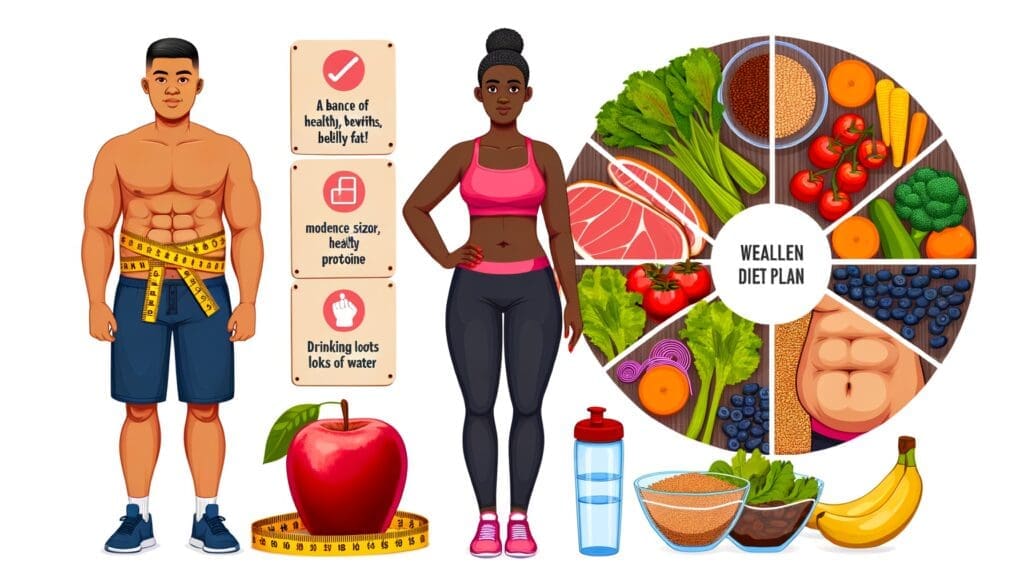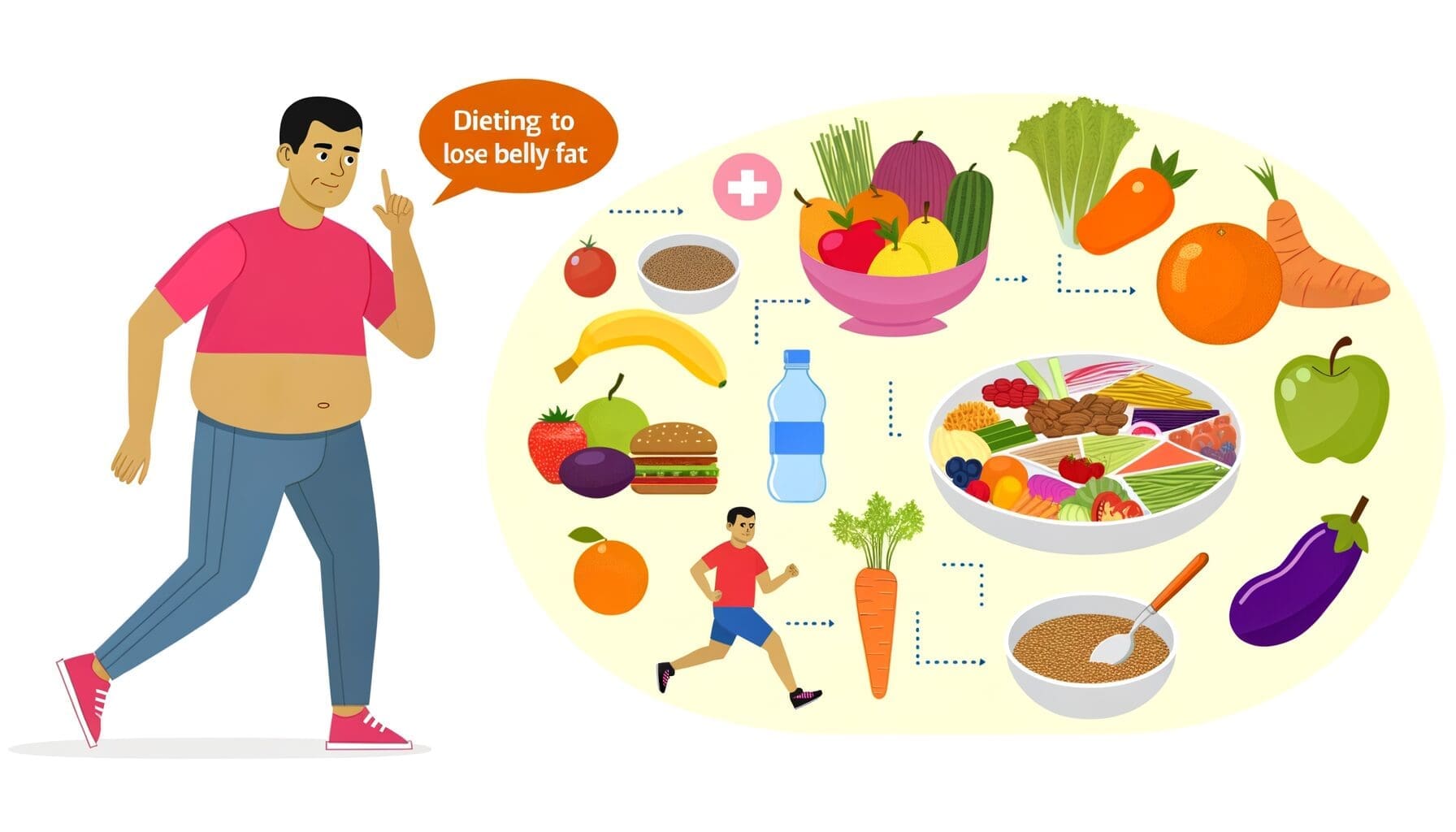The Impact of Excess Belly Fat on Health
Excess belly fat can have serious health implications, impacting various well-being aspects. Research shows that individuals with high amounts of belly fat are at a higher risk of developing conditions such as heart disease, diabetes, and fatty liver disease. This type of fat, known as visceral belly fat, is not just a cosmetic issue but a significant health risk.
One way excess belly fat affects health is through its association with insulin resistance, a condition where cells in the body do not respond effectively to insulin, leading to high blood sugar levels. This can increase the risk of developing type 2 diabetes. Additionally, excess belly fat is linked to inflammation in the body, which can further contribute to the development of chronic diseases.
Furthermore, having too much belly fat can result in increased levels of stress hormones, which may lead to conditions like sleep apnea and high blood pressure. Excess belly fat can also interfere with the body’s overall metabolism and hormone regulation, affecting factors such as appetite control and fat storage.
In some cases, individuals who appear “skinny fat” – having a normal body weight but high belly fat – may still be at risk for health complications associated with excess abdominal fat. Adopting a health-promoting lifestyle that includes regular physical activity, a balanced diet low in processed carbs and sugars, and sufficient sleep is a good idea to combat these risks. Incorporating healthy habits like aerobic exercise, resistance training, and interval training can help reduce belly fat and improve overall body composition. Individuals can mitigate the health risks associated with excess abdominal fat by making these lifestyle changes and dieting to lose belly fat.
Guidelines for Dieting to Lose Belly Fat
Dieting to lose belly fat effectively, it is important to focus on making dietary changes that promote fat loss in the abdominal area. Research shows that certain dietary habits can play a significant role in slimming down the waistline. Here are some dietary recommendations for reducing belly fat:
- Limit consumption of foods high in refined carbs and sugars, as these can lead to weight gain, particularly around the abdominal area.
- Include plenty of soluble fiber in your diet from sources such as fruits, vegetables, and whole grains. Fiber helps to aid digestion and can contribute to a feeling of fullness, which may prevent overeating.
- Incorporate protein-rich foods such as lean meats, eggs, legumes, and dairy products into your meals. Protein can help increase muscle mass and promote fat loss.
- Consume healthy fats from sources like fatty fish, nuts, seeds, and olive oil. These fats can provide essential nutrients and support overall health. Limit consumption of saturated and trans fats.
- Stay hydrated by drinking plenty of water throughout the day. Sometimes, thirst can be mistaken for hunger, leading to unnecessary calorie consumption.
- Limit alcohol intake, as excessive consumption can contribute to the accumulation of visceral belly fat.
- Consider incorporating intermittent fasting into your routine as a way to manage calorie intake and promote fat loss. This approach involves cycling between periods of eating and fasting.
By making these dietary changes, along with regular physical activity and lifestyle adjustments, you can effectively and safely use dieting to Lose Belly Fat. It is important to remember that spot reduction of fat in specific areas is not possible, so overall body fat loss is key to slimming down the waistline.

Effective Exercises for Targeting Belly Fat
Incorporating a mix of exercises into your routine can be highly beneficial when aiming to reduce belly fat. Research shows that aerobic exercise and resistance training effectively target belly fat. Aerobic exercises like running, swimming, or cycling help burn calories and improve overall health by reducing the risk of heart disease and diabetes. On the other hand, resistance training, such as lifting weights, builds muscle mass, which can boost metabolism and aid in fat loss.
Interval training, a form of exercise that alternates between high-intensity bursts and low-intensity recovery periods, has been shown to be particularly effective in reducing belly fat. Additionally, incorporating intermittent fasting and stress-reducing activities into your routine, such as getting enough sleep and practicing regular physical activity, can also help shed excess belly fat.
Making healthy food choices is crucial when dieting to lose belly fat. Consuming plenty of soluble fiber in foods like oats, legumes, and fruits can help reduce belly fat by promoting fullness and aiding in digestion. Cutting back on carbs and limiting the consumption of sugary beverages and alcohol can also contribute to fat loss. Including foods like fatty fish and green tea in your diet, which have been linked to fat loss benefits, can be a good idea.
In summary, a combination of targeted exercises, healthy diet choices, and lifestyle changes can effectively reduce belly fat in a healthy way. By incorporating these effective tips into your routine, you can work towards decreasing visceral belly fat and overall body fat, reducing the risk of various health conditions such as high blood pressure, insulin resistance, and fatty liver disease.
Guidelines for Reducing Heart and Diabetes Risks with Waistline Measurements
Based on research and studies, it is recommended to monitor waistline measurements, as they can indicate potential health risks such as heart disease and diabetes. Maintaining a healthy waist size is crucial for reducing the risks associated with these conditions. Researchers suggest that a waist size of over 35 inches for women and 40 inches for men can increase the likelihood of developing these diseases.
Incorporating lifestyle changes based on waistline measurements is essential to reducing heart and diabetes risks. Engaging in regular aerobic exercises, interval training, and resistance training can help decrease visceral belly fat and improve overall body composition. Getting enough sleep is also important as it helps regulate stress hormones that can contribute to weight gain around the midsection.
Additionally, focusing on a balanced diet by consuming plenty of soluble fiber, fatty fish, and unsaturated fats while limiting carbs and alcohol intake can aid in weight management. Intermittent fasting and incorporating green tea into dieting to lose belly fat have also been shown to have health benefits and support fat loss.
In conclusion, by monitoring waist size and adopting effective tips like regular exercise and a healthy diet, individuals can work towards reducing heart and diabetes risks in a safe and sustainable manner. Making these lifestyle changes is good for overall health and well-being.
The Influence of Health-Conscious Peers on Lifestyle Choices
Research shows that surrounding ourselves with health-conscious friends can significantly impact our eating and exercise habits. Spending time with individuals who prioritize their health makes us more likely to adopt similar behaviors. These friends might encourage us to engage in regular aerobic exercise or try new forms of physical activity like interval training, which can help reduce overall body fat and specifically target belly fat.
Moreover, hanging out with health-focused peers can influence our food intake choices. We may find ourselves opting for green tea over sugary beverages or incorporating fatty fish into our diets for its health benefits. Our friends may introduce us to effective tips such as intermittent fasting or consuming plenty of soluble fiber to aid in fat loss and improve our body composition.
By being around individuals who prioritize their health, we are more likely to make lifestyle changes that support weight loss and reduce the health risks associated with carrying too much belly fat. This includes lifting weights to increase muscle mass and minimize visceral belly fat, as well as managing stress levels to lower the production of the stress hormone cortisol, which can contribute to fat storage around the midsection.
In essence, spending time with health-conscious friends can create a supportive environment that promotes a healthy way of living, from maintaining a balanced diet to engaging in regular physical activity. Research has shown that social influences play a significant role in shaping our behaviors, and surrounding ourselves with individuals who prioritize health can motivate us to make positive choices for our well-being.
Genetics and Fat Storage: Can Your DNA Determine Your Belly Fat?
Can genetics influence where fat is stored in the body?
Research shows that genetics can indeed play a role in determining where fat is stored in the body. Some individuals may have a genetic predisposition to store more fat in certain areas, such as the belly. This can be due to variations in genes that regulate fat metabolism and distribution.
When it comes to where fat is stored, two main types are often discussed: subcutaneous fat, which lies just under the skin, and visceral fat, which surrounds the abdominal organs. Genetics can influence the balance between these two types of fat in the body.
For example, some people may have a tendency to store more visceral fat due to their genes, which can be concerning as visceral fat is more metabolically active and has been linked to a higher risk of health issues like heart disease and diabetes. On the other hand, others may be more prone to storing subcutaneous fat, which, while still affecting appearance, may not pose as many health risks.
While genetics can affect where fat is stored, lifestyle factors such as diet and exercise also significantly affect overall body fat distribution. By adopting a healthy diet, engaging in regular physical activity, and incorporating effective tips like aerobic exercise, resistance training, and interval training, individuals can work towards reducing belly fat and improving their overall body composition, regardless of their genetic predispositions.
Detecting Visceral Fat: How to Identify and Address Unhealthy Levels
Simple methods can be utilized to determine if one has an unhealthy amount of visceral fat. Research shows that a key indicator is waist size. Men with a waist circumference above 40 inches and women above 35 inches are more likely to have excessive visceral fat. Another way to assess is by measuring body mass index (BMI). A BMI over 30 is often associated with high levels of visceral fat.
Researchers have found that such cases may also exhibit health issues like high blood pressure, diabetes, and heart disease. Aerobic exercise and resistance training can help decrease visceral fat levels, leading to a healthier body composition. Getting enough sleep and managing stress levels is also essential, as stress hormones can contribute to fat accumulation around the belly.
In conclusion, identifying excess belly fat can be crucial for overall health, as excess visceral fat is linked to various health risks. Implementing lifestyle changes such as healthy eating habits, regular physical activity, and adequate sleep can help reduce visceral fat naturally and effectively.
Lifestyle Tweaks to Say Goodbye to Belly Fat: Expert Tips
Incorporating certain lifestyle changes can be highly effective in reducing belly fat. Research shows that getting enough sleep is crucial, as lack of sleep can lead to weight gain, including belly fat. Engaging in regular aerobic exercise, such as running or swimming, can help combat belly fat and reduce the risk of heart disease.
In addition to aerobic exercise, building muscle mass through resistance training is essential for fat loss. Interval training, like HIIT workouts, can also be beneficial in reducing overall body fat, including belly fat. For those looking to specifically target belly fat, intermittent fasting and incorporating green tea into their diet may be effective strategies.
Making adjustments to food intake is also key. Consuming plenty of soluble fiber, found in foods like oats and legumes, can help reduce visceral belly fat. Limiting carb intake and steering clear of excessive alcohol consumption can also help shed excess belly fat. Yes, these changes are called dieting to lose belly fat.
Moreover, managing stress levels is crucial, as the stress hormone cortisol can contribute to the accumulation of belly fat. Practicing stress-reducing activities such as yoga or meditation can be a good idea for overall health and weight management.
By implementing these lifestyle changes, individuals can work towards reducing belly fat in a healthy way and lowering the risk of health issues associated with excess abdominal fat, such as diabetes and high blood pressure.
Strategies for Reducing Belly Fat: Diet and Exercise Approaches
A combination of proper diet and exercise strategies is crucial to effectively reducing belly fat. Research shows that a healthy diet coupled with regular physical activity can lead to significant changes in body composition, specifically targeting visceral belly fat.
One effective dietary strategy is to consume a balanced and nutritious diet low in processed foods, sugars, and unhealthy fats. Foods rich in soluble fiber, such as fruits, vegetables, and whole grains, can aid in weight loss by keeping you full longer and regulating blood sugar levels. Additionally, incorporating sources of unsaturated fats, like fatty fish and nuts, can support overall health and contribute to fat loss.
When it comes to exercise, a mix of aerobic exercises, resistance training, and high-intensity interval training (HIIT) can be beneficial for burning calories and building muscle mass. Aerobic exercises, such as running or swimming, help burn calories and reduce overall body fat, including belly fat. On the other hand, resistance training, like lifting weights, can increase muscle mass and boost metabolism, leading to more effective fat loss.
In terms of lifestyle changes, getting enough sleep is crucial. Research suggests that inadequate sleep can lead to weight gain and increased levels of the stress hormone cortisol, which can promote belly fat storage. Moreover, managing stress levels through activities like yoga or meditation can also aid in reducing belly fat.
In conclusion, adopting a healthy way of eating, staying physically active, and making sustainable lifestyle changes are effective tips for losing belly fat and improving overall health. It is important to remember that spot reduction of fat is not possible, and the focus should be on reducing overall body fat through a combination of diet and exercise approaches.
Cardio Workouts: A Key to Shedding Belly Fat
Increasing daily activity levels is crucial in reducing belly fat. Here are some effective tips to help you incorporate more activity into your daily routine:
- Start by incorporating aerobic exercises such as brisk walking, running, swimming, or cycling. These activities can help burn calories and reduce overall body fat, including visceral belly fat.
- Incorporate interval training into your workout routine. This involves alternating between high-intensity bursts of exercise and lower-intensity recovery periods. Research shows that this type of exercise can be particularly effective in burning fat.
- Try to lift weights or engage in resistance training a few times a week. Building muscle mass can help increase your metabolism and burn more calories throughout the day.
- Make small lifestyle changes such as taking the stairs instead of the elevator, parking farther away from your destination, or doing household chores like gardening or cleaning. These activities can add up and increase your overall physical activity levels.
- Set specific goals for daily steps or active minutes and track your progress using a fitness tracker or app. This can help keep you motivated and accountable.
By incorporating these tips into your daily routine, you can increase your daily activity levels and reduce belly fat in a healthy way. Remember, consistency is key, so find activities you enjoy and make them a regular part of your lifestyle.
The Effectiveness of High-Intensity Interval Training (HIIT) in Belly Fat Loss
Cardiovascular exercises are essential to any weight loss or fat loss journey, especially when targeting belly fat. Some types of cardio exercises that can help in reducing belly fat include aerobic exercises like running, cycling, and swimming. Aerobic exercises elevate the heart rate and help burn calories effectively.
Another type of cardio exercise that is particularly effective in reducing belly fat is interval training. This involves alternating between high-intensity activity bursts followed by short rest periods or lower-intensity exercise. Research shows interval training can be more effective in burning fat, including visceral belly fat, than steady-state cardio exercises.
Additionally, incorporating resistance training into your workout routine can also aid in reducing belly fat. Resistance training helps build muscle mass, which in turn can boost metabolism and promote fat loss, including in the abdominal area.
In conclusion, a combination of aerobic exercises, interval training, and resistance training can be a powerful way to target belly fat and improve overall body composition. Remember, consistency and a balanced approach that includes both exercise and proper nutrition are key in achieving sustainable results in reducing belly fat.
Debunking the Myth: Are Sit-Ups and Crunches Effective for Belly Fat?
Is relying on sit-ups and crunches effective in eliminating belly fat?
When it comes to shedding excess belly fat, many people turn to sit-ups and crunches as their go-to solution. However, it is essential to debunk the myth that these exercises alone are effective in targeting belly fat. While sit-ups and crunches can help strengthen and tone the abdominal muscles, they do not specifically target or eliminate fat in that area.
Research shows that spot reduction, the concept of targeting fat loss in specific areas of the body through exercise, is a myth. To effectively reduce belly fat, a combination of factors such as a healthy diet, regular exercise, and lifestyle changes are crucial. Incorporating aerobic exercise, resistance training, and interval training into your fitness routine can help boost metabolism, burn calories, and promote overall fat loss, including in the abdominal region.
In addition to exercise, maintaining a balanced diet plays a significant role in losing belly fat. Consuming a diet rich in whole foods, plenty of soluble fiber, lean protein, and healthy fats like those found in fatty fish and unsaturated fats can support fat loss. Limiting the intake of refined carbs, sugary beverages, and processed foods can also help reduce the overall body fat percentage.
Furthermore, getting enough sleep, managing stress levels, and staying hydrated are also effective tips for promoting a healthy body composition and reducing belly fat. By adopting a holistic approach that combines proper nutrition, regular physical activity, and lifestyle modifications, individuals can achieve sustainable and long-term fat loss results rather than relying solely on sit-ups and crunches.
Muscle Development and Calorie Burning: Understanding the Connection
Research shows that there is a strong relationship between muscle development and burning calories. Muscles are metabolically active tissues, which means they require energy to function. When you engage in resistance training, such as lifting weights, you build muscle mass and increase your metabolic rate. This means that your body will continue to burn calories even at rest to maintain these newly developed muscles.
In addition to building muscle mass, aerobic exercises like interval training and high-intensity interval training (HIIT) can also help in burning calories. These types of exercises elevate your heart rate and increase calorie expenditure during and after the workout. Furthermore, incorporating resistance training into your exercise routine can effectively boost muscle development and calorie burning.
Overall, focusing on muscle development through resistance training and combining it with aerobic exercises can be a good idea for burning calories and losing belly fat. Additionally, getting enough sleep and managing stress are important factors supporting muscle development and overall health.

The Ketogenic Diet: A Solution for Losing Belly Fat?
The ketogenic diet is a high-fat, low-carbohydrate eating plan that has gained popularity for its potential weight loss benefits. The body enters a metabolic state called ketosis by significantly reducing carb intake and replacing it with fats. During ketosis, the body becomes efficient at burning fat for energy, including stored fat around the belly area.
Research shows that the ketogenic diet can be effective in reducing visceral belly fat, which is harmful fat stored around the abdominal cavity and linked to various health risks such as heart disease and diabetes. By limiting carb consumption, the body reduces its insulin levels, leading to a decreased storage of fat. This can help target stubborn belly fat that is otherwise hard to lose.
In addition to its potential fat-burning benefits, the ketogenic diet has shown positive effects on overall body composition. Some studies suggest that following a keto diet may help preserve muscle mass while promoting fat loss, leading to a healthier body weight and reduced risk of diseases associated with obesity.
While the ketogenic diet may offer a promising solution for losing belly fat, it is essential to approach it in a healthy way. Consulting with a healthcare provider or a nutritionist before starting any new diet is always a good idea, as individual needs vary. Combining the ketogenic diet with other effective tips like regular physical activity, including resistance training and aerobic exercises, may further enhance the results in losing belly fat.
Effective Diet and Exercise Approaches for Reducing Belly Fat
To reduce belly fat effectively, it is essential to incorporate a combination of dietary changes and exercise routines into your lifestyle. Research shows that targeting specific foods and physical activities can help in achieving this goal. Here are some diet and exercise strategies that can assist in reducing belly fat:
Dietary Strategies: – Incorporate plenty of soluble fiber in your diet by consuming foods like oats, flaxseeds, and fruits. Soluble fiber helps reduce belly fat by promoting a feeling of fullness and aiding digestion. – Limit the consumption of fruit juice and foods high in sugar as they can contribute to weight gain, especially around the abdominal area. – Opt for a diet rich in unsaturated fats, such as those found in avocados, nuts, and olive oil, as they can help in reducing visceral belly fat.
Exercise Approaches: – Engage in aerobic exercises like running, swimming, or cycling to burn calories and reduce overall body fat, including belly fat. – Incorporate interval training or HIIT (High-Intensity Interval Training) into your workout routine to boost metabolism and burn calories effectively. – Include resistance training or weightlifting in your exercise regimen to build muscle mass, which can help in burning more calories even at rest.
By combining these effective tips with lifestyle changes such as getting enough sleep, managing stress levels, and staying physically active, you can work towards reducing belly fat in a healthy way. Remember, consistency is key to seeing results in losing belly fat and improving your overall body composition.
Intermittent Fasting: A Method for Reducing Belly Fat
Intermittent fasting is a dietary approach that involves cycling between periods of eating and fasting. This method focuses more on when to eat rather than what to eat. By restricting the time window for eating, intermittent fasting can help regulate the body’s insulin levels and promote fat burning.
Studies have shown that intermittent fasting may directly impact belly fat reduction, particularly the harmful visceral fat that surrounds the organs in the abdominal cavity. Visceral fat is linked to various health risks, such as heart disease, diabetes, and fatty liver disease. By incorporating intermittent fasting into your routine, you may be able to specifically target this deep-seated fat that is difficult to lose through traditional dieting methods.
During the fasting periods, the body starts tapping into its fat stores for energy, including the stubborn belly fat. This process may lead to a reduction in overall body fat percentage, including the fat accumulated around the waist. Additionally, intermittent fasting can help improve body composition by preserving muscle mass while promoting fat loss, especially in the abdominal area.
In summary, intermittent fasting can be an effective and healthy way to reduce belly fat and improve overall health. However, for optimal results, it’s essential to combine this approach with a balanced diet, regular exercise, such as aerobic and resistance training, and enough sleep.









Be First to Comment